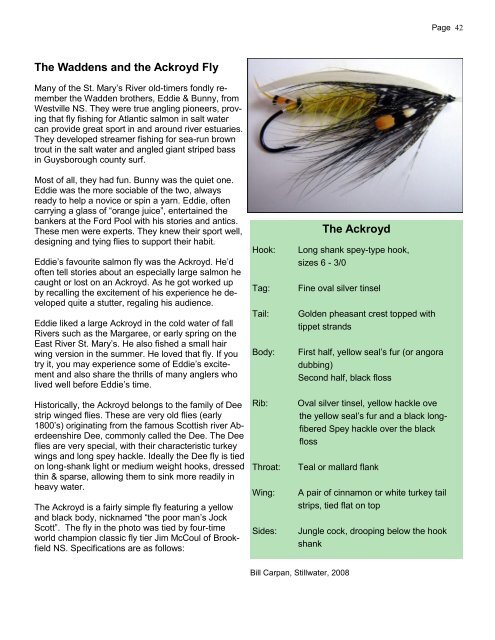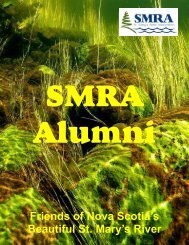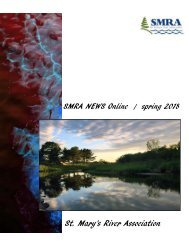2018 SMRA NEWS Online (NXPowerLite Copy)
You also want an ePaper? Increase the reach of your titles
YUMPU automatically turns print PDFs into web optimized ePapers that Google loves.
Page 42<br />
The Waddens and the Ackroyd Fly<br />
Many of the St. Mary’s River old-timers fondly remember<br />
the Wadden brothers, Eddie & Bunny, from<br />
Westville NS. They were true angling pioneers, proving<br />
that fly fishing for Atlantic salmon in salt water<br />
can provide great sport in and around river estuaries.<br />
They developed streamer fishing for sea-run brown<br />
trout in the salt water and angled giant striped bass<br />
in Guysborough county surf.<br />
Most of all, they had fun. Bunny was the quiet one.<br />
Eddie was the more sociable of the two, always<br />
ready to help a novice or spin a yarn. Eddie, often<br />
carrying a glass of “orange juice”, entertained the<br />
bankers at the Ford Pool with his stories and antics.<br />
These men were experts. They knew their sport well,<br />
designing and tying flies to support their habit.<br />
Eddie’s favourite salmon fly was the Ackroyd. He’d<br />
often tell stories about an especially large salmon he<br />
caught or lost on an Ackroyd. As he got worked up<br />
by recalling the excitement of his experience he developed<br />
quite a stutter, regaling his audience.<br />
Eddie liked a large Ackroyd in the cold water of fall<br />
Rivers such as the Margaree, or early spring on the<br />
East River St. Mary’s. He also fished a small hair<br />
wing version in the summer. He loved that fly. If you<br />
try it, you may experience some of Eddie’s excitement<br />
and also share the thrills of many anglers who<br />
lived well before Eddie’s time.<br />
Historically, the Ackroyd belongs to the family of Dee<br />
strip winged flies. These are very old flies (early<br />
1800’s) originating from the famous Scottish river Aberdeenshire<br />
Dee, commonly called the Dee. The Dee<br />
flies are very special, with their characteristic turkey<br />
wings and long spey hackle. Ideally the Dee fly is tied<br />
on long-shank light or medium weight hooks, dressed<br />
thin & sparse, allowing them to sink more readily in<br />
heavy water.<br />
The Ackroyd is a fairly simple fly featuring a yellow<br />
and black body, nicknamed “the poor man’s Jock<br />
Scott”. The fly in the photo was tied by four-time<br />
world champion classic fly tier Jim McCoul of Brookfield<br />
NS. Specifications are as follows:<br />
Hook:<br />
Tag:<br />
Tail:<br />
Body:<br />
Rib:<br />
Throat:<br />
Wing:<br />
Sides:<br />
The Ackroyd<br />
Long shank spey-type hook,<br />
sizes 6 - 3/0<br />
Fine oval silver tinsel<br />
Golden pheasant crest topped with<br />
tippet strands<br />
First half, yellow seal’s fur (or angora<br />
dubbing)<br />
Second half, black floss<br />
Oval silver tinsel, yellow hackle ove<br />
the yellow seal’s fur and a black longfibered<br />
Spey hackle over the black<br />
floss<br />
Teal or mallard flank<br />
A pair of cinnamon or white turkey tail<br />
strips, tied flat on top<br />
Jungle cock, drooping below the hook<br />
shank<br />
Bill Carpan, Stillwater, 2008






